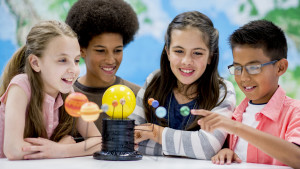
It’s all too easy, while employing various aspects of instructional design and delivery, to overlook ways that students might also engage in learning through nonlinguistics.
When used intentionally and consistently, nonlinguistic representations are powerful instructional tools that can have a positive effect on student achievement. They provide varied ways for students to process new information without solely relying on language.
McREL’s analysis of research for the second edition of Classroom Instruction that Works (CITW) provides these research-based classroom recommendations for use of nonlinguistic representations:
- Use graphic organizers.
- Use physical models or manipulatives.
- Generate mental pictures.
- Use pictures, illustrations, and pictographs.
- Engage in kinesthetic activities.
Tips for engaging in nonlinguistic learning
- Consistently use each type of nonlinguistic representation.
It’s important that students learn several ways to represent information nonlinguistically. This means providing students at every grade level with multiple opportunities to use kinesthetic movement, draw pictures and pictographs, use their senses and emotions to form solid mental images, be fluid in the use of several graphic organizers, and create or use physical models to denote their learning. Consistent use is key; if you use these strategies only occasionally, it will limit students’ ability to grasp the possibilities associated with learning both linguistically and nonlinguistically, preventing them from developing automaticity in their use of all the representations. - Help students engage in conversations with peers to explain their choice and use of a nonlinguistic representation.
When students engage in peer discourse to explain why they chose a certain nonlinguistic representation for the content being studied, they deepen their understanding of the content and are better able to make connections between types of information. Peer conversations help students elaborate on their learning; they describe their thinking and listen to others do the same, helping them extend and apply their learning. When students engage in peer and classroom conversations, it becomes easier to expose and correct any confusion about or misinterpretations of the content. Using sentence stems and guiding questions may also help students become more proficient in speaking with, listening to, and understanding one another. - Students can use multiple nonlinguistic representations to learn or represent a concept.
It would be a mistake to believe that students should select only one nonlinguistic strategy to represent a piece of content. Nothing could be further from the truth. When students are encouraged to combine and use multiple nonlinguistics to represent their learning, the probability of deeper understanding and longer retention increases. For example, students learning the vocabulary word defenestrate, which means to throw something out the window, might kinesthetically demonstrate the word, followed by sketching what it looks like to defenestrate. Ultimately, students should be given time to create a mental picture of how they look defenestrating an object. - Students should be encouraged to use nonlinguistic representations on their own.
Nonlinguistic representations can be used to learn new vocabulary words, take notes, capture information along a timeline, symbolize information that is difficult to see—such as parts of an atom or solar systems—depict historical events, connect new learning to previously learning information, and demonstrate understanding beyond linguistics. When students consistently represent their learning using a nonlinguistic approach, they internalize useful methods and multiple ways to process and make sense of new information. Ultimately, the goal is to create a desire in students to use these learning tools without teacher insistence.
Applying the tips to instruction
As with the implementation of any instructional strategy, teachers who wish to improve student learning need to intentionally plan for and consistently use nonlinguistic representations in their lesson design and delivery. Setting a purpose for using these important instructional strategies, along with a willingness to stay the course in their application, will go a long way to establishing routine use for teachers and the students they have the privilege of serving.

Additional resources
Beck, I. L., McKeown, M. G., & Kucan, L. (2002). Bringing words to life: Robust vocabulary instruction. New York: Guilford Press.
Dean, C. B., Hubbell, E. R., Pitler, H., & Stone, B. (2012). Classroom instruction that works: Research-based strategies for increasing student achievement, 2nd ed. Alexandria, VA: ASCD.

Hello,
Do you have training for instructional coaches to support teachers in the classroom
Retha
Retha, yes, we do offer training and coaching services for instructional coaches. If you’re interested in having McREL work with your school/district on coaching, you can contact us at 800.858.6830 or info@mcrel.org. Thank you for your comment!
Is their a web training for using nonlinguistics representation
Hi, Tony – We are developing a series of online PD courses about a variety of instructional topics. While we don’t have one planned specifically on non-linguistic representation at this time, check the Learn Online section of our website from time to time to see the latest classes that are available.
I feel that every competent teacher uses or encourages the use of Non-Linguistic learning material in their course materials currently.
I found this to be very accurate and informational. Thanks!
This is very helpful to make sure all students learning styles are being met. Also, allowing students to discuss with their peers in small group and use hands on will help them to better understand the lesson being presented and stick in their long term memory.
Students can use multiple nonlinguistic representations to learn or represent a concept of nonlinguistic strategy is very interesting information for educators to know and I like
when students are encouraged to combine and use multiple linguistic to understand.